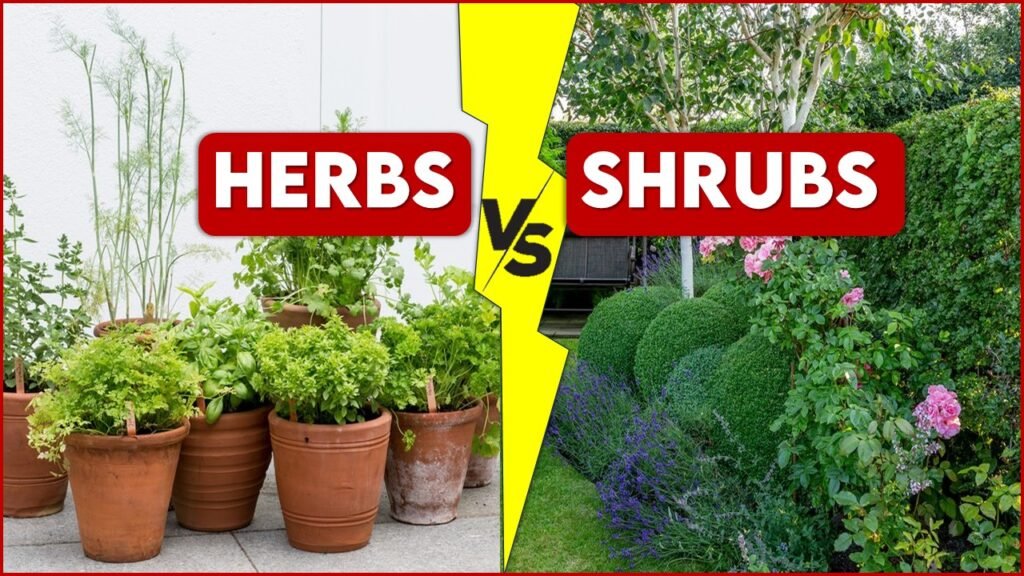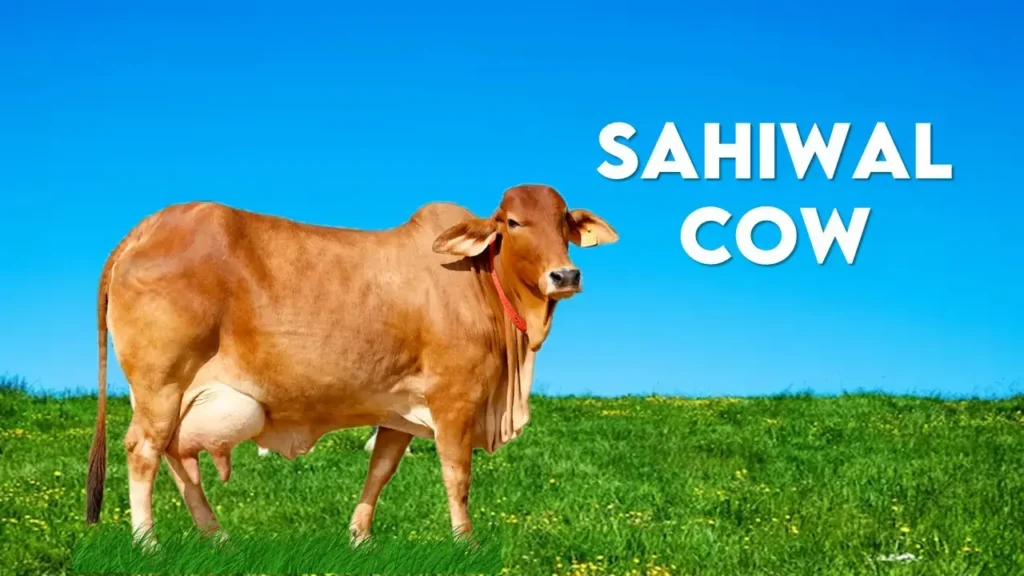Plants are the gift of nature, Without plants nature is incomplete. There are various types of plants on the earth according to their appearance, size, place of growth, shape, etc. Herbs, shrubs, and trees are categorized on the basis of their growth habit. We will discuss the difference between herbs and shrubs in this article briefly.
What is Herbs?
Herbs are small terrestrial non-woody plants that bear leaves, stems, flowers, fruits, and all plant parts, desired for their aromatic and medicinal properties, and can grow as perennials, biennials, or annuals has a great significance on the ecosystem by providing habitat for wildlife, pollinator’s food, and soil health.
Examples of Herbs
- Rosemary (popularly used in aromatherapy and cooking),
- Cilantro,
- Dill, Fennel
- Tulsi,
- Ginger,
- Garlic,
- Oregano (used in Italian food like pizza, pasta, etc.),
- Cardamon(used as spices),
- Mint (refreshing herb),
- Thyme,
- Lavender(used in perfume industry),
- Chives ( onion flavored herb).
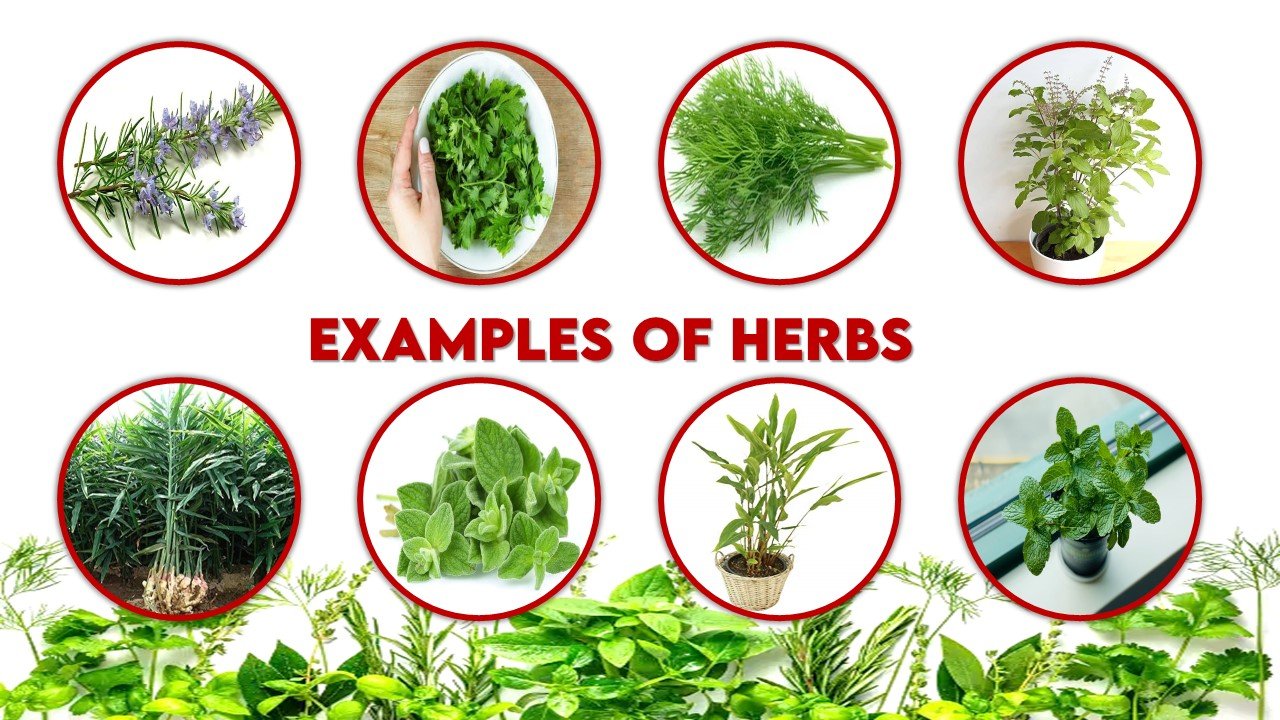
Uses of Herb
Herbs are used for multiple purposes like in culinary, medicine, ornamental, etc. There are various types of shrubs found in India, Let’s discuss it in detail-
Taste Enhancer for Culinary Purposes:
Herbs are highly used in the cooking sector as a test enhancer in sweet as well as savory dishes. Extra aroma and a fresh texture are achieved by using different herbs in food. Dill, rosemary, mint, basil, oregano, etc. are heavily used in pasta, pizza, sauces, desserts, etc.
Medicinal Value:
Herbs contain antioxidant properties, used as medicinal plants in India. From a very ancient time, it has been used in the Ayurvedic sector for preventing various mental and physical health for example basil, ginger, and cardamon So, evidence in curing coughs and colds. Insecticidal properties are also found in it.
Cosmetic Industry:
Due to its pleasant fragrance herbs are highly used in the cosmetic sector. In skincare, hair care, and toothpaste industries herbs can also be used. The essential oils present in lavender and geranium are used in the perfume industry due to their sweet fragrance.
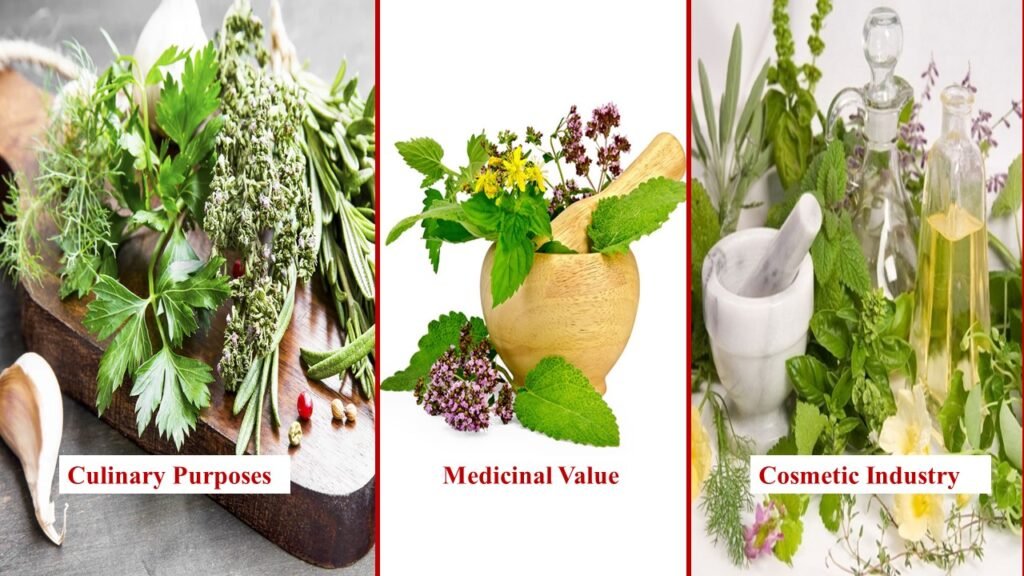
Ornamental Purpose:
Herbs are also used for beautification purposes. They plant in the park, and gardens for ornamental purposes. Lavender is most suitable for the ornamental sector.
Also Read
- Top 15 Medicinal Plants and Their Uses: Best Herbal Medicine
- 15 Best Highest Oxygen Producing Plants
What is Shrubs ?
Shrubs are woody terrestrial plants that bear stems, branches, flowers, fruits, and seeds, larger than herbs but smaller than trees. Shrubs grow to a certain height with multiple branches around the base above the ground giving a bushy or shrubby appearance.
Examples of Shrubs:
- Hibiscus,
- Bougainvillea (aesthetic beautification purposes),
- Champa,
- Rose (ornamental plant),
- Juniper,
- Blueberry (fruiting shrubs),
- Lilac,
- Boxwood (for making topiaries),
- Rhododendron (evergreen shrub),
- Spirea (deciduous shrubs),
- Azalea,
- Hydrangea,
- Bengal currant, Holly,
- Jasmine (used in perfume-making),
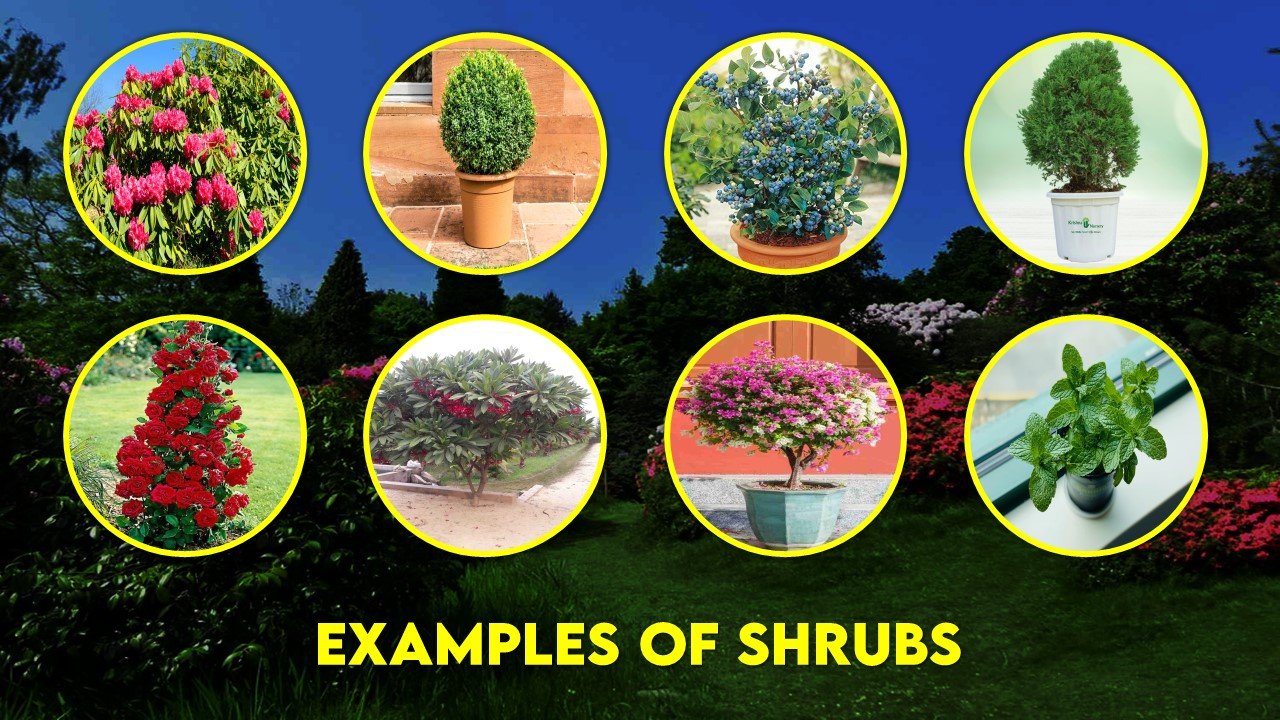
Tyes of Shrubs – on The Basis of Structure:
Shrubs are classified based on their canopy size.
- Closed shrubs: This type of shrub has a dense canopy of greenery about 70% to 100%.
- Open shrubs: it is a mid-density foliage having 30% to 70% coverage.
- Tall shrubland: this type of shrub possesses less number of leaves. Canopy size is almost 10% to 30%.
- Tall open shrubland: this type of shrub possesses a very small canopy. The canopy size is about less than 10%.
Uses of Shrub:
Shrubs are utilized for various purposes such as fuelwood production, medicinal, and ornamental, livestock feed, soil conservation, etc.
Beautification Purpose:
Shrubs are commonly used in parks and gardens as decorative plants. For entrance and gate, Bougainvillea is one of the best choices among people. Topiaries are created using shrubs in gardens which add value to the tourism industry.
Medicinal Sector:
Some shrubs contain antioxidants in essential oils which are used in medicinal sectors.
Cosmetic Industry:
Shrubs contain pleasant fragrances that are used in the perfume industry. Shrubs are also used in moisturizer production which can boost the cosmetic industry.
Feed of Livestock and Fuelwood:
The leaves of shrubs are used as feed for cattle. As shrubs are woody plants, we can get fuelwood from shrubs.
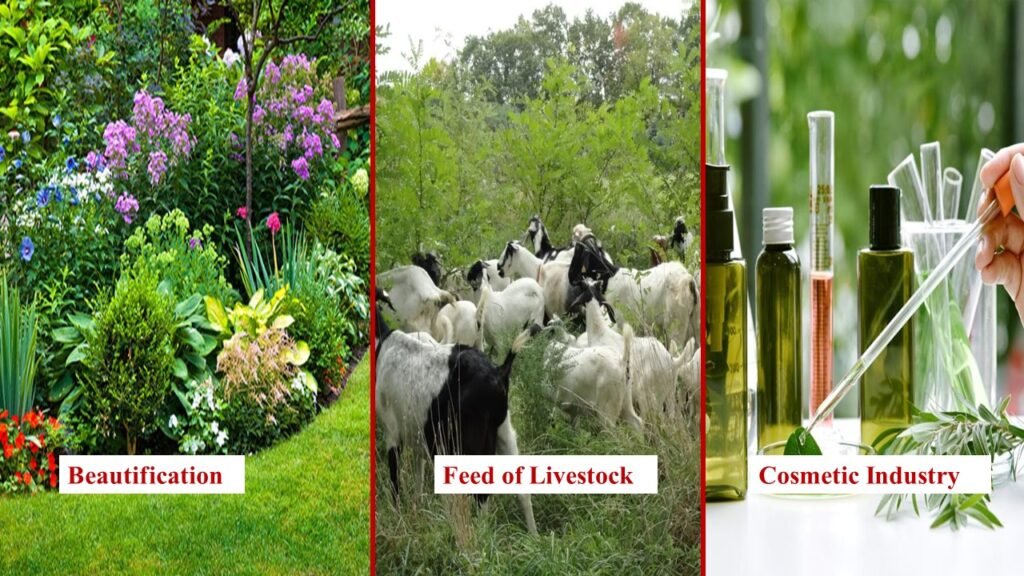
Soil Conservation:
Shrubs are deep-rooted plants. Shrubs prevent soil erosion by binding the soil particles in their root system.
Fruits Production:
Shrubs (like oranges) produce fruits that increase the economy of our country. Roots are also consumed by many people.
Also Read
- Top 25 Shrubs Plants in India for a picturesque garden
- 15 Indoor Plants for Oxygen That Boost Your Health
Difference Between Herbs And Shrubs
Based on Structure:
let’s see the difference between herbs and shrubs based on their height, stem texture, branching pattern, tissue type, stem thickness, and synonym-
| Component | Herbs | Shrubs |
| Height | Short height plant, less than one-meter height. | Taller than herbs, height is variable from one meter (compact small) to several meters (large shrubs). |
| Stem texture | Soft, flexible, non-woody stem. | Woody, rigid, durable stem, provides support to plants. |
| Branching pattern | They are unbranched. | Multiple branches are found near the base of the plant above the ground level. |
| Tissue type | Soft and delicate tissue is observed. | Shrubs have strong and woody tissue. |
| Stem thickness | Thin plant. | Thick woody stem. |
| Another name | They are also known as rootstocks. | Another name is woody or shrubby plants. |
| Example | Rosemary, Cilantro, Dill, Fennel, Tulsi, etc. | Hibiscus, Bougainvillea, Champa, Rose, Holly, Juniper, Blueberry, Lilac, Boxwood |
Based on Lifespan And Life Cycle:
Difference between herbs and shrubs based on their lifespan and life cycle-
| Component | Herbs | Shrubs |
| Lifespan | They are short-lived plants, lifespan ranging from a few months to a few years. | Lifespan ranges from several years to several decades. |
| Life cycle | Herbs may be annual, biennial, or sometimes perennial in nature. | Shrubs must be perennial in nature as they can live year after year. |
Based on Reproduction Strategy:
Difference between herbs and shrubs based on their reproduction method-
| Component | Herbs | Shrubs |
| Reproduction strategy | The primary means of reproduction in the case of herbs is through seeds, but they can also reproduce through rhizome, stolon, offset, etc. | Shrubs can reproduce through both sexual and asexual means through seeds and root suckers respectively. |
Based on Climate And Soil Requirement:
Difference between herbs and shrubs based on their requirement to grow properly-
| Component | Herbs | Shrubs |
| Climate and soil requirement | Most herbs require 4 to 8 hours of sunlight and a good drainage facility. | Shrubs require fertile soil, a good drainage facility, and an optimum condition for growth condition. |
Based on Survival Capacity in The Environment:
Difference between herbs and shrubs based on their survival capacity-
| Component | Herbs | Shrubs |
| Survival capacity in the environment | As they are weak plants, they can’t survive adverse conditions. | Their survival rate in adverse conditions is higher than herbs as they are woody in nature. |
Different Adaptation Strategies of Herbs and Shrubs in The Environment:
Plant uses different adaptation strategies based on different environmental conditions like, water use efficiencies, nutrient acquisition strategies, temperate tolerance, etc.
Water Use Efficiency:
Different herbs and shrubs adapted to water scare conditions by developing a small leaf area, a layer of waxy material to reduce transpiration and a deep rooting system to aquire more water.
Nutrient Acquisition:
Herbs and shrubs can grow in poor fertile soil compared to other field crops by fixing nitrogen through a symbiotic relationship with mycorrhiza fungi. their rooting system is also extensively grown to acquire more nutrients.
Temperature Tolarence:
Herbs and shrubs are eurythermal in nature means they are adapted to a wide range of temperatures. Some of them can withstand freezing temperatures by showing dormancy. As well as they can grow in extreme temperatures by adapting to different physiological conditions.
How to conserve And Manage Herbs And Shrubs in Nature:
Now plants are in danger due to high civilization and industrialization. We have to conserve the herbs and shrubs to protect the balance of the ecosystem, soil, and water conservation, and to protect the aesthetic beauty of nature. We can manage the herbs and shrubs in the following ways-
- Habitat Conservation: We need to conserve different areas where herbs and shrubs grow naturally like different national parks, wildlife sanctuaries botanical gardens, avenue plantations, etc., and also need to prevent the destruction and degradation of such areas.
- Ex-situ and In-situ Conservation: Herbs and shrubs conservation can also be achieved by establishing botanical gardens, natural parks, and seed banks through conserving genetic diversity. Their diversity will increase by using seeds, cuttings, and tissue culture.
- Restoration and Rehabilitation of Herbs and Shrubs: We can restore degraded habitats by restoring soil fertility, erosion control, reforestation, and afforestation. Thus, habitat quality and biodiversity are increased.
- Control The Entry of Invasive Species: Invasive plant species may threaten the survival of native herb and shrub species, so, they must be controlled by manual removal, application of herbicide, and biological control using different natural enemies available in nature.
- Fire Management: Implementation of the described burning and wildfire suppression strategy to maintain a healthy fire-adapted ecosystem with the help of different government services.
- Sustainable Harvesting: Herbs and shrubs have different commercial, medicinal, and cultural values. Essential to harvest them in a proper way so that they can be long-lasting.
- Involvement of Community: The local people and stakeholders should be engaged in different conservation and management programs by educating them and conducting awareness camps. Local people can also help by providing their indigenous knowledge and resources.
- Research and Monitoring: By conducting different research and monitoring programs the status of herbs and shrubs can be improved in nature. It will increase the dimension of this category in mankind.
Conclusion:
There are different types of plants in nature, herbs and shrubs are two types of plant. They have a very long historical Importance and uses from long back. Herbs and shrubs differ in their biological characters, reproductive strategies and also field of importance. Herbs basil, ginger have medicinal value, parsley, oregano used as species, cilantro, lavender have essential oils used in pharmaceutical industry etc. Shrubs also have importance in different field like hibiscus and bougainvillea are flowering plant. Rhododendron is evergreen shrub used in landscaping, Jasmine used in perfume making etc. Mostly shrubs are used as barrier crop in many village side areas. They also play an important role in conservation of nature and natural resources.
Latest Post
- September Issue 2025- Times of Agriculture Magazine
- Top 15 Fertilizer Companies in the World
- Top 10 Vegetable Farming Profit Per Acre in India
- August 2025 : Times of Agriculture Magazine (AgriVoltaics Farming)
- Button Mushroom Farming: Infrastructure, Cultivation, and Profitability
- Sahiwal Cow: Characteristics, Milk per Day, Price and Origin
- July 2025 : Times of Agriculture Magazine
- June Issue (2025) – Times of Agriculture Magazine
- How to Create Modern Commercial Greenhouse Agriculture


